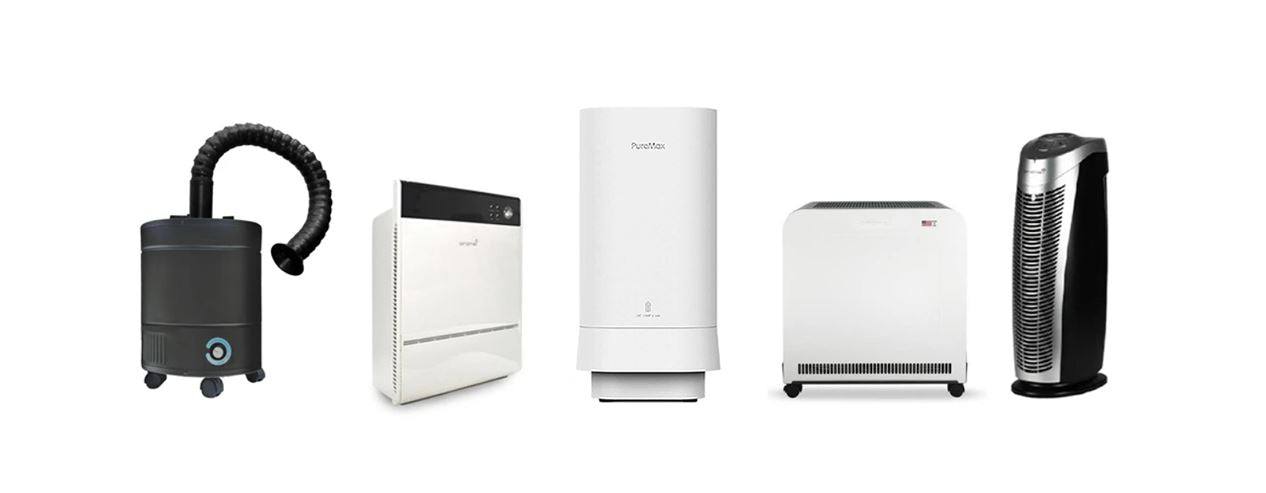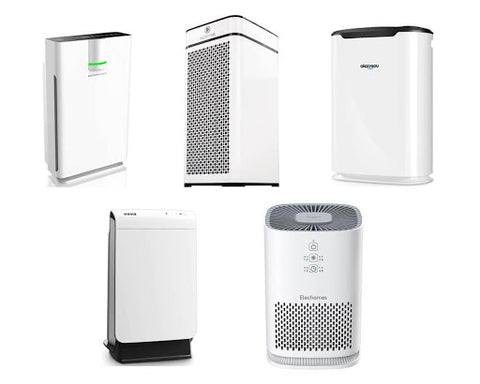
What is an Air Purifier, How it Works, and How to Select One
The coronavirus infection, popularly called COVID-19, has seen an enormous surge across the globe. This is causing the majority population to stay indoors- increasing the number of hours spent within the walls of the house. This is done in order to protect oneself against this infection as numerous researches provide enough evidence that wearing a mask and consistently practicing good social distancing can significantly reduce the spread of the coronavirus via droplet transmission.
Media attention and news about possible aerosol transmission have many people thinking about air purifiers and their efficacy. People have a lot of concerns. For instance, how do the different types of air purifiers work? How many of them are effective against the COVID-19 infection? And should we get an air purifier for our homes?
According to the United States Environmental Protection Agency, when used correctly, air cleaners and HVAC (Heating, ventilation, and air conditioning) filters can help in reducing airborne contaminants, including viruses in a compact or small space. Shelly Miller, a researcher in the field of environmental engineering at the University of Colorado-Boulder, agrees that portable air cleaners are very efficient at removing viral particles from indoor air. However, air-purifying or filtration is not enough to protect people from coronavirus. Nevertheless, when used along with other approved practices recommended by the Centre for Disease Control and other public health agencies, including social distancing and mask-wearing, filtration can be part of a plan to reduce the potential for airborne transmission of COVID-19 indoors.
Vizocare Healthcare, a leading healthcare equipment company, has answered some of these questions for us.

What are the various types of air cleaners/purifiers available in the market?
The majority of air purifiers fall into two categories: filters or sanitizers—some are a combination of both the types in the same machine. Filters are typically designed to improve indoor air quality by removing the tiny particles of matter floating around — like dust, pollen, and pet dander. Unfortunately, all these things occur naturally and can aggravate peoples' allergies if inhaled. The most common type of air purifier filters available right now is called HEPA filters.
Air sanitizers are efficiently designed to destroy bacteria, viruses, mold, or fungal spores that can also be floating around in the air. These things occur naturally, but they too can make you sick if there are high enough concentrations in the air. One of the most common types of sanitizer in the market right now is Ultraviolet (UV) light devices.

How do these HEPA filters and UV light air purifiers function?
HEPA is an acronym for "high-efficiency particulate air." As this name suggests, these filters are really good at literally pulling harmful germs and particles out of the air. These filters hold onto them so that they cannot be recirculated in the air. The fibers present in a HEPA filter are designed to catch and trap particles as tiny as .01 micron in diameter — just a very small fraction of the width of a single strand of a human hair!
UV light devices, on the other hand, technically do not remove anything from the air. Instead, they are actually designed to kill any type of virus, bacteria, or mold spores floating around by exposing them to ultraviolet (UV) light.
There is a lot of discussion about an alternative type of air purifiers (ionizers and ozone generators)
What are these ionizers, and how do they function?
Ionizers provide air particles with an electrical charge, which pulls them toward anything with an opposite electrical charge. These objects may be the collector plates present within these devices themselves or ant surfaces around the room (curtains, walls, carpets, ceilings, upholstery). But once they've located something they are attracted to, the particles have a tendency to stay there; it's pretty similar to the concept of static electricity. While ion generators can remove tiny particles (including tobacco smoke) from the indoor air, they do not remove gases or odors. They may be relatively ineffective in removing large particles such as pollen and house dust allergens.
What are ozone generators? How do these units work?

Ozone generators bring about substantial changes in the typical oxygen molecule such that it has three atoms instead of just the usual two. This three-atom molecule is called ozone. It interacts very differently with its environment than the typical air we breathe does. Ozone is a lung irritant. It is produced indirectly by ion generators and some other electronic air purifiers. Ozone generators directly produce it. While indirect ozone production is of slight concern, there is an even more significant concern with the direct type and purposeful introduction of a lung irritant into indoor air. FDA (Food and Drug Administration) has set an upper limit of 0.05 parts per million of ozone for medical devices. So, when considering buying an ionizer or ozone generating air purifier, make sure the level of ozone it generates is within the safety zone.
Are all of these devices safe and efficient to use?
No, not all can be safe and efficient to use. Air purifiers that have HEPA filters or use UV light or ionizers are fine. However, inhaling ozone can cause throat irritation, coughing, shortness of breath, and other respiratory issues, even in fit people. Ozone can even lead to lung damage, which is why local weather authorities issue timely ozone surge alerts to the people of that area. People who have asthma or other respiratory problems can be extremely sensitive to the air quality, so they need to restrict their exposure to ozone by either staying inside on those days or avoid heavy exertion while outside. As advised by the EPA, we must not use ozone generators in occupied spaces. When not used according to public health standards, ozone applied to indoor air does not effectively remove viruses, bacteria, mold, or other biological pollutants.
Are any of the mentioned air purifiers effective against the novel coronavirus that causes COVID-19?
In terms of filtration, the coronavirus is at the lower spectrum of a HEPA filter's range, so it may not be 100% effective on just a single pass. But if a HEPA system is run repeatedly over a certain period, it can take out a big chunk of viruses — almost up to the high 90th percentile (99.94 to 99.97%). Also, a long enough exposure to UV light in an air purifying device can definitely weaken some viruses, including COVID-19 causing coronavirus.
Why should people use an air purifier during this COVID-19 pandemic?
Having an air purifier in your home or office has many benefits, including relieving symptoms of asthma and allergies, eliminating harmful chemicals, neutralizing odors, removing harmful radon, and even increase life expectancy. During a pandemic however, air purifier becomes an important factor in reducing the chances of airborne diseases, such as COVID-19. Air purifiers with HEPA filters capture the airborne droplets that carry bacteria and viruses, and a UV lamp can effectively disable all those pathogens. This is especially important if there are high risk people in your household or where you work.
What should a person look for when buying an air purifier?
According to Joseph Allen, director of the Healthy Buildings Program, Harvard University, ‘The air cleaner has to be employed as part of a multi-layered defense strategy.’
We must follow some criteria while purchasing an air purifier.
1) CADR (Clean Air Delivery Rate) - A Guide for air purifier unit ratings
The CADR rating system for air purifiers/cleaners helps gauge both the filter's efficiency that a particular device uses and how much air moves through it.
Units that use a HEPA filter -- a type of pleated mechanical air filter -- can remove at least 99.97% of dust, pollen, mold, bacteria, pathogens, and other particles with a size of 0.3 microns, according to the U.S. Environmental Protection Agency. These filters do not kill the virus, the way UV light can. However, that's not a critical factor in clearing the air of coronavirus particles.
You do not require UV or some other process because the virus is captured on the filter media. Once the virus particles have been captured, they do not further grow, and they cannot be released. So there is no need for anything other than an air purifier with a HEPA filter. It is simple, efficient, and essential.
2) Room size definitely matters!
The second important thing to take into consideration when choosing an air purifier is the size of the room where it will be used.
Everyone needs to size it suitable for the main room or any other rooms.
The higher the CADR rating, the larger the area it can serve. In general, product packaging can tell us the largest size area or room the unit can handle. Environmental engineers generally measure indoor air quality by air changes seen per hour (ACH). ACH value indicates the number of times the air inside a particular room is filtered every sixty minutes.
As a rule of thumb, experts recommend 4 to 6 air changes per hour for indoor spaces. That means that the entire air volume in a room is being cleaned and/or replaced every ten to fifteen minutes. That's enough to remove COVID-19 virus aerosols from the air and knock down transmission risk.
If your house is making you sick, an air purifier can solve that as well !
Vizocare air purifiers can also help rid the air of mold spores, stealthy radon gas, carpet dust, and debris, carbon monoxide gas, built up germs from a humidifier, curtain dust, harmful emissions from household cleaning products, dust from the air conditioning, and heating and fumes from lead paint.
For easy reference, "Just keep in mind that we recommend four to six air changes per hour, so a quick rule of thumb is to look for a portable air cleaner with a CADR of at least 300 for every 500 square feet of space."
The Environmental Protection Agency (EPA) provides a reliable guide for the minimum CADR levels needed for rooms of different sizes in its online Guide to Air Cleaners in the Home. For all rooms with eight-foot ceilings, it recommends:
- CADR of 65 for 100 square feet room
- CADR 130 for 200 square feet room
- CADR 195 for 300 square feet room
- CADR 260 for 400 square feet room
- CADR of 325 for 500 square feet room
- CADR of 390 for 600 square feet room
In addition, you can also use tools available online like the Harvard-CU Boulder Portable Air Cleaner Calculator for Schools online tool, which has been created to help the staff in educational institutes pick an effective air cleaner for the classes. This can give everyone a rough estimate for rooms of various sizes in their Home.
Remember, you need to clean/replace filters at regular intervals for air cleaners to do their job well, some every 3 months, others every 5 years, depending on the brand of the air purifier. If you are in the process of buying a device with a HEPA filter, it is essential to get consultation from experts, and follow the manufacturers' recommendations on maintenance and replacement.
What are some other things everyone can do to improve the overall indoor air quality at their homes?
Ensure the windows are open windows and turn on the fans to increase air circulation in the room. Use strategically positioned box or floor fans. Set the fans on the HVAC system to run constantly. Try and upgrade to a better quality air filter in the central air return system. Replace the filter frequently. The typical lifespan of a 1 inch thick home air filter is approximately 90 days. If the fan has been running continuously, consider replacing it once every forty-five days.
Air purifiers are neither a magic cure for COVID-19 nor are they a silver bullet solution to combating COVID-19 at home, but they can be very effective in reducing airborne transmission of the virus. Along with other strategies, like wearing a mask, using a face shield, social distancing, and disinfecting surfaces, this affordable equipment can have a significant role in keeping you safe from this pandemic. Vizocare houses great quality products and appliances to help protect us from this pandemic. Staying safe and taking all precautions will help us during these tough times.

Leave a comment